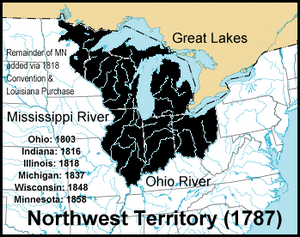Treaty of Fort Harmar facts for kids
The Treaty of Fort Harmar was an agreement signed in 1789 between the United States government and many Native American tribes. These tribes had claims to a large area of land called the Northwest Territory. This treaty tried to solve land disputes and bring peace, but it didn't work very well.
Contents
A Look Back: The Treaty of Fort Harmar

The Treaty of Fort Harmar was signed on January 9, 1789. It happened at Fort Harmar, which was near where Marietta, Ohio is today.
Leaders from the Six Nations and other tribes were there. These included the Wyandot, Delaware, Ottawa, Chippewa, Potawatomi, and Sauk. They met with Arthur St. Clair, who was the governor of the Northwest Territory. Other American leaders like Josiah Harmar and Richard Butler were also present.
Why Was This Treaty Needed?
This new treaty was supposed to fix problems left over from two earlier agreements. These were the 1784 Treaty of Fort Stanwix and the 1785 Treaty of Fort McIntosh. However, the Treaty of Fort Harmar mostly just repeated what those old treaties said. It made only a few small changes.
The treaty did not deal with the main concerns of the Native American tribes. One big problem was that new settlers from New England were moving into an area called the Firelands. This land was part of the Connecticut Western Reserve, which was set aside for the tribes.
Problems with the Negotiations
Governor Arthur St. Clair had permission from the U.S. Congress to offer some American lands back. This was meant to trade for the disputed Firelands. But St. Clair refused to give up these lands. Instead, he used threats and bribes to get a treaty signed. This treaty simply repeated the terms of the earlier agreements.
Many Native American leaders met before the treaty talks. They wanted to decide on the best plan. Joseph Brant, a Mohawk leader, suggested a compromise. He wanted the boundary line moved to the Muskingum River. Some leaders did not agree with Brant's idea.
Brant sent a letter to St. Clair asking for early agreements, but St. Clair said no. He even accused Brant of working for the British. Because of this, Brant decided not to join the talks with the United States. He also told others to do the same.
To make things worse, a white settler named Lewis Wetzel harmed Seneca Chief Tegunteh. This happened while Tegunteh was on his way to Fort Harmar. Wetzel was arrested but was never punished for his actions.
Several tribes, like the Shawnee and Miami, refused to take part in the treaty. This was because St. Clair would not attend or sign the treaty himself. So, these tribes also refused to follow the treaty's rules.
What Happened After the Treaty?
The new treaty did almost nothing to stop the fighting. There was a lot of violence between settlers and Native Americans along the frontier. Many Native American nations were very angry about the treaty. It said tribes could sell their lands, but it also claimed U.S. control. It also forced tribes to sell their lands right away.
The failure of this treaty led to more fighting. This became known as the Northwest Indian War. A new group called the Northwestern Confederacy formed. They fought against the settlers and the United States.
The war continued for six years. Thousands of people were killed. The U.S. Army suffered some of its worst defeats during this time. Finally, the United States defeated the tribal alliance at the Battle of Fallen Timbers in 1794.
In 1795, the Treaty of Greenville was signed. In this treaty, the tribes had to give up claims to most of what is now the state of Ohio. This treaty divided the Northwest Territory into two parts. One part was for the Native Americans, and the other was for the United States settlers.


